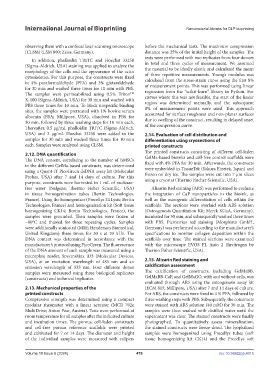Page 484 - IJB-10-6
P. 484
International Journal of Bioprinting Nanomaterial-bioinks for DLP bioprinting
observing them with a confocal laser scanning microscope before the mechanical tests. The maximum compression
(CLSM) (LSM 800; Zeiss, Germany). distance was 25% of the initial height of the samples. The
In addition, phalloidin TRITC and Hoechst 33258 tests were performed with two replicates from four donors
(Sigma-Aldrich, USA) staining was applied to analyze the in total and three cycles of measurement. We assumed
morphology of the cells and the appearance of the actin the material to be ideally elastic and calculated the mean
cytoskeleton. For this purpose, the constructs were fixed of three repetitive measurements. Young’s modulus was
in 4% paraformaldehyde (PFA) and 3% glutaraldehyde calculated from the stress-strain curve using the first 8%
for 30 min and washed three times for 10 min with PBS. of measurement points. This was performed using linear
The samples were permeabilized using 0.5% Triton regression from the “scikit-learn” library in Python. For
TM
X-100 (Sigma-Aldrich, USA) for 30 min and washed with curves where this was not feasible, the start of the linear
PBS three times for 10 min. To block unspecific binding region was determined manually, and the subsequent
sites, the samples were pretreated with 1% bovine serum 8% of measurement points were used. This approach
albumin (BSA; Millipore, USA), dissolved in PBS for accounted for surface roughness and non-planar surfaces
30 min, followed by three washing steps for 10 min each. due to swelling of the construct, resulting in delayed onset
Thereafter, 0.5 μg/mL phalloidin TRITC (Sigma-Aldrich, of the compression curve.
USA) and 2 μg/mL Hoechst 33258 were added to the 2.14. Evaluation of cell distribution and
samples for 30 min and washed three times for 10 min differentiation using cryosections of
each. Samples were analyzed using CLSM. printed constructs
2.12. DNA quantification The printed constructs consisting of different cell-laden
The DNA content, correlating to the number of hMSCs GelMa-based bioinks and cell-free control scaffolds were
in the different GelMa-based constructs, was determined fixed with 4% PFA for 30 min. Afterwards, the constructs
using a Quant-iT PicoGreen dsDNA assay kit (Molecular were embedded in TissueTek (Sakura Finetek, Japan) and
Probes, USA) after 7 and 14 days of culture. For this frozen on dry ice. The samples were cut into 7 µm slices
purpose, constructs were harvested in 1 mL of nuclease- using a cryostat (Thermo Fischer Scientific, USA).
free water (Nalgene; Thermo Fisher Scientific, USA) Alizarin Red staining (ARS) was performed to evaluate
in tissue homogenization tubes (Bertin Technologies, the integration of CaP nanoparticles in the bioink, as
France). Using the homogenizer (Precellys 24 Lysis; Bertin well as the osteogenic differentiation of cells within the
Technologies, France) and homogenization kit (Soft tissue scaffolds. The sections were overlaid with ARS solution
homogenizing CK14; Bertin Technologies, France), the (Osteogenesis Quantitation Kit; Merck KGaA, Germany),
samples were grounded. Then samples were frozen at incubated for 30 min, and subsequently washed three times
−80°C and thawed for three repeating cycles. Samples with PBS. Picrosirius red staining (Morphisto GmbH,
were additionally sonicated (MSE; Henderson Biomedical, Germany) was performed according to the manufacturer’s
United Kingdom) three times for 30 s at 20 kHz. The specifications to monitor collagen deposition within the
DNA content was determined in accordance with the scaffolds over time. The stained sections were examined
manufacturer’s protocol using PicoGreen. The fluorescence with the microscope EVOS FL Auto 2 (Invitrogen by
of the DNA amount of each sample was measured using a Thermo Fisher Scientific, USA).
microplate reader, SpectraMax iD3 (Molecular Devices,
USA), at an excitation wavelength of 485 nm and an 2.15. Alizarin Red staining and
emission wavelength of 535 nm. Four different donor calcification assessment
samples were measured using three biological replicates The calcification of constructs, including GelMaBB,
(constructs) and technical triplicates. GelMaBB-CaP, and GelMaGO, with and without cells, was
evaluated through ARS using the osteogenesis assay kit
2.13. Mechanical properties of the (ECM 815; Millipore, USA) after 7 and 14 days of culture.
printed constructs For ARS, the constructs were fixed in 4 % PFA, followed by
Compressive strength was determined using a compact three washing steps with PBS. Subsequently, the constructs
modular rheometer with a linear actuator (MCR 702e were stained with ARS solution (40 mM) for 30 min. The
MultiDrive; Anton Paar, Austria). Tests were performed at samples were then washed with distilled water until the
room temperature for all samples after the indicated culture supernatant was clear. The stained constructs were finally
and incubation times. The porous, cell-laden constructs photographed. To quantitatively assess mineralization,
and cell-free porous reference scaffolds were printed the stained constructs were freeze-dried. The lyophilized
and cultivated for 7 or 14 days. The diameter and height samples were homogenized using Precellys tubes (soft
of the individual samples were measured with calipers tissue homogenizing kit CK14) and the Precellys soft
Volume 10 Issue 6 (2024) 476 doi: 10.36922/ijb.4015

